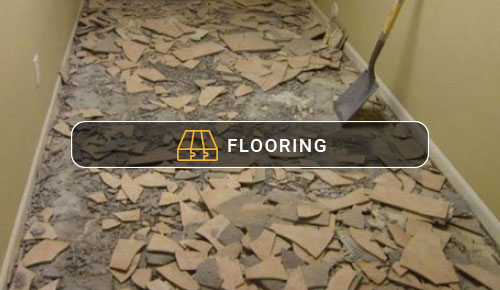Removing floor tile can be difficult; not to mention also time-consuming.
Your tile may be attached to bare cement, plywood, mason board, or even affixed to a previously installed floor. No matter what, removing a tile floor takes time, effort, skill, and patience.
Here’s how to remove any tile…
EMPTY THE ROOM
Empty the room completely. Turn off the water supply before removing a sink or toilet. If removing a toilet, drain reservoir, remove bolt, and gently rock the fixture to break wax seal.
PICK A STARTING POINT
If your tile has been installed around a vanity or other semi-permanent fixture, a bare edge will be exposed, providing a good starting point for removal. If the tile is placed wall to wall, it may be necessary to use a hammer and chisel to break out a tile to create a starting point. Tiles may be attached using adhesives or mortar and may come up easily or require great effort, depending on how it was affixed, as well as the type of underlayment used. A hammer and chisel, pry bar, or pole scraper can be used to remove tiles.
REMOVE TILE
Continue to pry up the tile. Deposit tiles in a trashcan or large bucket as they are removed. Remember that tile can be heavy and an overfilled waste receptacle will be difficult to haul away – so keep emptying it out.
ACCESS UNDERLAYMENT
Tile may have been attached directly to a concrete floor or sub-floor, but a plywood or mortarboard underlayment is common. An inappropriate or damaged underlayment should be removed. Some may be left in place for re-use. Access the underlayment and remove to expose the sub-floor, if applicable.
CLEAR DEBRIS
Take a broom or shop vac and clear away any and all debris.
REMOVE EXPOSED NAILS
If an underlayment has been removed, it may be necessary to remove or pound in exposed nails to leave behind a flat surface.
INSPECT FLOOR
Once the old tile floor has been removed, inspect the subfloor for damage that my need to be repaired before a new floor is installed. Patch or replace any rotten wood or divots in concrete floors. The subfloor should be smooth and damage-free before a new tile floor is installed.

Feel free to stop into Builder Supply Outlet or the Edge Showroom with any home improvement questions you may have regarding tile, backsplash, windows, kitchen cabinets, remodeling, construction, contractors, designing/installing a new kitchen or bathroom — or anything else. We can help you through the entire design and installation process from A-Z. Or call us anytime in Broadview, IL at 1-708-343-3900. You can also make an appointment to meet with one of our Edge Kitchen and Bathroom designers at no charge by clicking here.
